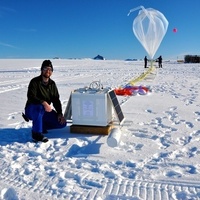Physics and Astronomy Ph.D. Thesis Defense - Brett Anderson - Dartmouth College
Title: "Studying Radiation Belt Electron Precipitation with BARREL During a Quiet Solar Cycle"
Abstract:
The Van Allen Radiation Belts are highly complex and dynamic regions surrounding Earth in which protons and electrons are accelerated to relativistic energies and trapped by Earth's magnetic field. Better understanding the source and loss processes for these energetic particles remains a particularly important goal for many space physics applications. The Balloon Array for Radiation Belt Relativistic Electron Losses (BARREL) mission studies one of the two main mechanisms by which energetic electrons are lost from the Van Allen Belts: so-called ``precipitation'' into the atmosphere. To date, a total of 54 stratospheric balloon flights have carried identical BARREL detectors that measure the resultant bremsstrahlung X-rays from precipitating electrons incident on the upper atmosphere. Meanwhile, Solar Cycle 24 (January 2008 to present) has had the fewest number of sun spots of any solar cycle since 1750, resulting in a relatively quiet magnetosphere.
Early BARREL measurements detected electron precipitation concurrently with small geomagnetic storms. These were also accompanied by large enhancements of radiation belt electron fluxes. To investigate the effect of small storms on radiation belt dynamics, electron flux data from two sets of geostationary orbiting satellites are analyzed over more than an entire solar cycle. It is found that the size of a storm is uncorrelated with the effect on energetic electrons. Geomagnetic storms, whether small, moderate, or large, may greatly enhance, have no effect on, or deplete radiation belt electron fluxes.
Microbursts have been suggested to be a significant cause of electron precipitation, though the spatial scale over which microbursts occur remains unknown. A microburst event on 13 August 2015 is investigated using data from a BARREL payload and four CubeSats. The complementary measurements yield a series of snapshots as the microburst region evolves in time. The event lasted for 9~hours and extended from L of 5 to 10 and from (at minimum) MLT of 09:00 to 13:00. Spectral analysis is performed to determine the energy spectrum and total loss rate of the electron microbursts. It is thusly shown that, even though this event occurred during a relatively quiet period, the radiation belts remain a highly dynamic region surrounding Earth.
